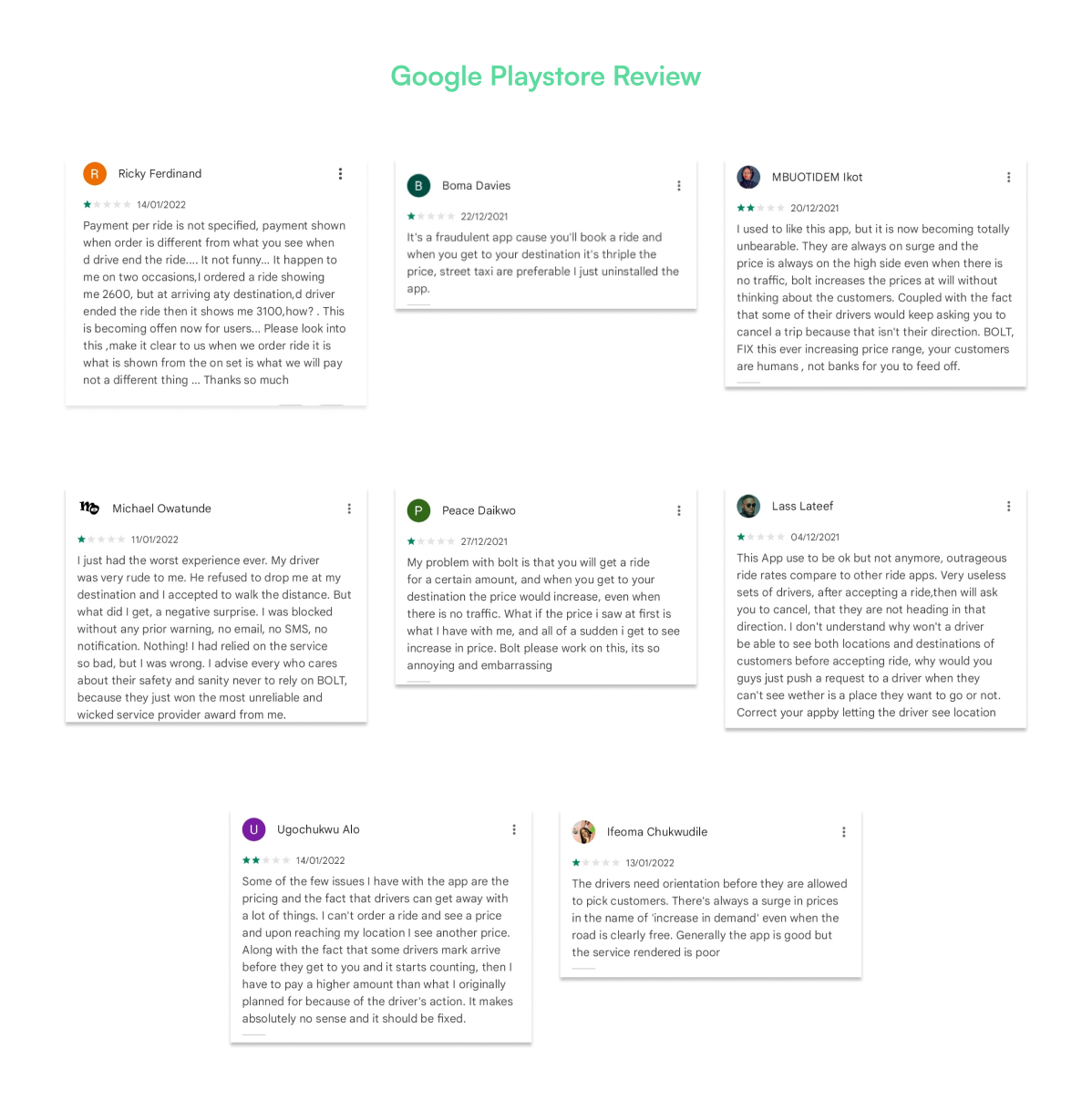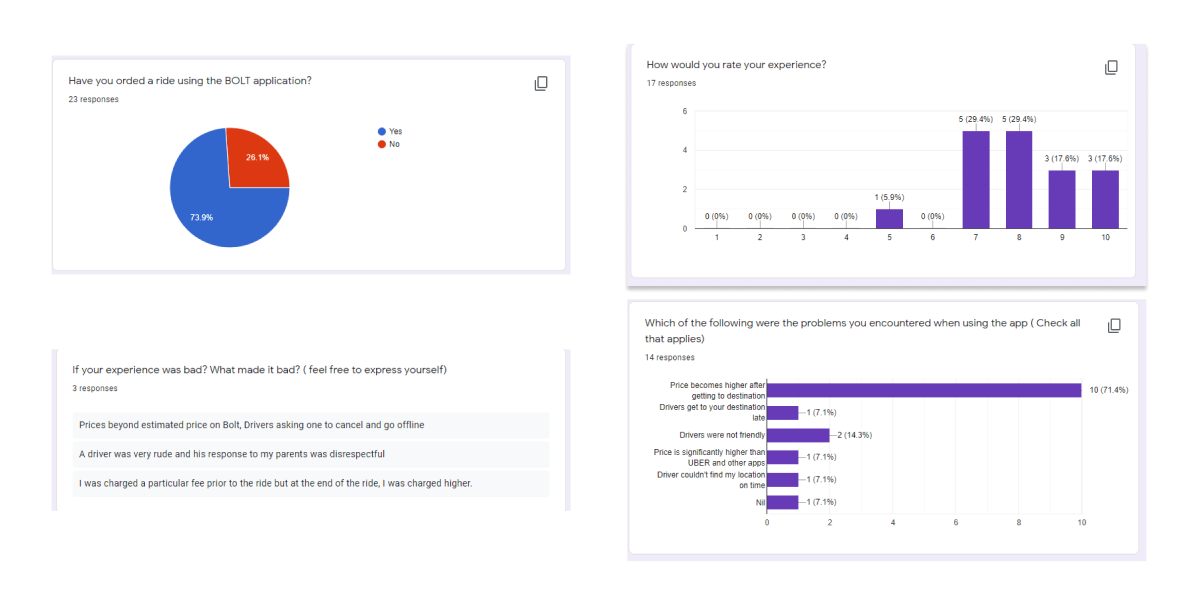Role
UX Designer
UX Researcher
Overview
Bolt is the first European super-app, aiming to make
urban mobility more affordable, safe, and sustainable.
Their mission is to help people save time, money, reduce
stress, and enhance cities, while empowering millions of
entrepreneurs such as drivers, couriers, restaurant
owners, and store owners.
Bolt embodies the essence of freedom of movement and
strongly believes that cars should be accessible to all
at a low price. However, the fluctuation in ride prices
can be discouraging for those with limited financial
means. Bolt's pricing model, which changes based on
traffic and time, often fails to provide customers with
sufficient prior information. This contradicts their
mission of saving money and making transportation
affordable. Customers can find it frustrating when the
price increases after booking a car, as they may not
have enough funds to cover the updated cost. The delayed
information leads to a poor user experience.
What is the Problem?
1.
Users often experience ride prices changing
after they reach the bus stop, resulting in them
having to pay more than initially anticipated.
This can pose a significant problem if the user
does not have sufficient funds to cover the
increased cost.
2.
Users may have a negative driving experience
with a particular driver, yet they might still
be suggested the same driver for another ride.
3.
Users often encounter significantly higher ride
prices compared to traditional rates.
Objectives
1.
Design a feature that enables customers to
anticipate and prepare for price changes
resulting from factors such as traffic and time,
ensuring that the updated prices do not come as
a surprise to them.
2.
Design a feature that empowers users with the
ability to choose their preferred driver for a
ride.

Research Objectives
-
Understand users' overall experience with the
app and service.
-
Understand and evaluate users view on the
pricing of rides
-
Identify specific pain points of users and
provide appropriate solutions.
Research Process
- Secondary Research
- Competitive analysis
- User Survey
1. Secondary Research
Based on my research on user reviews from the Google
Play Store, only a few people reported having a
positive experience with the app, while many users
encountered multiple issues. However, one common and
consistent problem emerged: the price changing after
reaching the destination due to surges or peak
times. This dynamic frustrated users and led to
numerous complaints.
Furthermore, users expressed dissatisfaction with
the quality of driver services, with one individual
stating that drivers should receive orientation
before being allowed to pick up customers. Although
a star rating system exists, it does not necessarily
determine which drivers are suggested to users.

2. Competitive Analysis
I downloaded both the Bolt and Uber apps to
assess their user experience and overall feel.
However, I was unable to download the Lyft
app as it is not available in my country.
Therefore, my research on Lyft was based on
secondary sources such as websites and user
reviews. In order to differentiate themselves
and embody their respective goals, competitors
often introduce unique features that set them
apart.
Strengths

Competitors in the ride-hailing industry
have specific goals that are reflected in
their distinctive features. Bolt aims to
provide affordable ride prices, catering to
customers across various income ranges,
which contributes to their growing market
share, particularly in countries like the
US.
Uber, on the other hand, focuses on
affordability through features like
ride-sharing, initially introduced by Lyft.
This reduces ride costs and helps lower the
carbon footprint by optimizing vehicle
usage. Uber's commitment to sustainability
is further emphasized by allowing multiple
drop-offs, offering users a range of
convenient options.
Lyft pioneered the concept of ride-sharing,
bridging the gap between public
transportation and private cars. This
approach saves money and reduces carbon
emissions by reducing the number of vehicles
on the road. Lyft's comprehensive background
checks for drivers contribute to passenger
safety, addressing concerns such as
incidents of driver misuse. Driver selection
is not solely based on star ratings but also
incorporates thorough background checks.
Weaknesses

Every one of them had similar business
models that used dynamic pricing. A pricing
system that depends on different factors
such as weather, traffic, time, etc. This
enables them to maximize their profit.
However, the time when the price is revealed
to you differs. Uber and Lyft tell you their
price before taking the ride while Bolt
tells you the price after you get to the
destination.
3. User Survey
To gain insights into users' frustrations and pain
points regarding price changes and the driving
experience, a survey was conducted. The survey
collected responses from 26 participants and
included relevant questions to validate the issues
identified in the secondary research.
Relevant survey responses

The user survey further validated the problems
identified in the secondary research.
.
71% of the participants said that the
price became higher after getting to the
destination
.
14% of the participants said that the
drivers were not friendly.
“I was charged a particular fee prior to the ride
but at the end of the ride, I was charged higher” -
Participant
User Persona
I created two fictitious personas to represent the
needs and frustrations of a larger group of Bolt
users.
Solution
1. Pricing
Bolt and other mobility service
providers use a pricing system known as
Dynamic or Surge pricing.
Dynamic pricing is a pricing strategy
that allows firms to modify product
prices in response to changing demand.
The pricing strategy is aimed at getting
the best price for a particular product
or service in response to changing
factors. This pricing methodology is
adopted by several industries, such as
event ticketing, hospitality, real
estate, and transportation.
Bolt and other mobility services give
prices based on several variables like
traffic patterns, weather conditions,
time, competitor prices, distance, and
demand.
Should Dynamic pricing be removed from
bolt?
Dynamic or surge pricing provides a
fairly accurate method of setting prices
for their ride as a number of variables
such as traffic and demand are not
predictable.
Removing dynamic or surge pricing
without having an accurate system of
predicting prices would put the company
and drivers at a disadvantage. Variables
like traffic and demand are
unpredictable, and dynamic pricing
provides a fair method of setting
prices. Without it, the company may
experience losses if variables change
during the ride, and rides could be
overpriced, potentially leading riders
to switch to competitors.
I firmly believe that dynamic pricing
should continue to be utilized as AI and
other prediction systems used for
pricing variables are often not entirely
accurate.
If dynamic pricing should stay, what
then is the problem?
The research findings indicate that Bolt
informs their customers about price
changes after the ride, which leads to a
feeling of being deceived among
customers. The issue is not solely about
paying an additional amount, but rather
the change from the agreed-upon price.
Consistency is valued by users, and
discovering the price change after the
ride worsens the overall experience.
Uber solved this by providing upfront
pricing before the ride, which is
beneficial in terms of transparency.
However, it can result in losses for the
company if there are changes in the
variables during the ride that affect
the cost.
Information
Riders are notified during the ride
about surge pricing, which prepares them
for an increase in price. This ensures
transparency and provides riders with an
understanding of the reasons behind the
price change.
This approach eliminates the surprise
and unpreparedness associated with
sudden price changes. It gives riders
the opportunity to add funds to their
account if needed, ensuring they have
enough money to cover the adjusted fare.
The price increase is communicated to
the customer, and they are given the
option to proceed with the ride or
cancel if they find the new price
unfavorable.
The goal is preparedness and acceptance.
Users will be informed about the price
hike in advance and given the choice to
proceed with the ride or not, ensuring
that they are aware of the increased
price and have the autonomy to make an
informed decision.
They won't feel deceived or cheated
because they have willingly accepted the
increased price before proceeding with
the ride.
2. Driving Experience
Bolt automatically fixes you to the nearest
available driver. It is true that you are
allowed to rate the driver after a ride. but
the ratings are only used by the Bolt to
determine if the driver should remain on the
platform. Users should have the ability to
choose their driver based on ratings and
location, as they are the ones taking the
ride. This gives them control and ensures
they are not paired with a driver they had a
negative experience with in the past.
Usability Test
Maze.co was used for conducting usability testing, where
users were asked to provide feedback on the overall
impression of the screens and suggest improvements for
enhancing the user experience.
Additionally, they were instructed to perform basic
operations associated with requesting a ride.


Key Takeaway
I began this project with the assumption that people
primarily use Bolt for its affordability and easy access
to remote areas. However, through my research,
particularly in my locality (Nigeria), I discovered that
many users prioritize comfort when choosing mobility
services like Bolt.
They are willing to pay the extra price per ride for the
experience of being in control.
I believe that these little adjustments will increase
Bolt's market share tremendously and boost revenue.